Mastering the Art of the Perfect Soft Boiled Egg
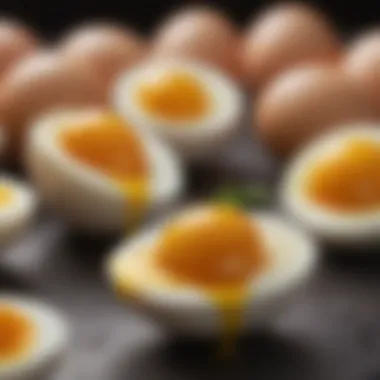
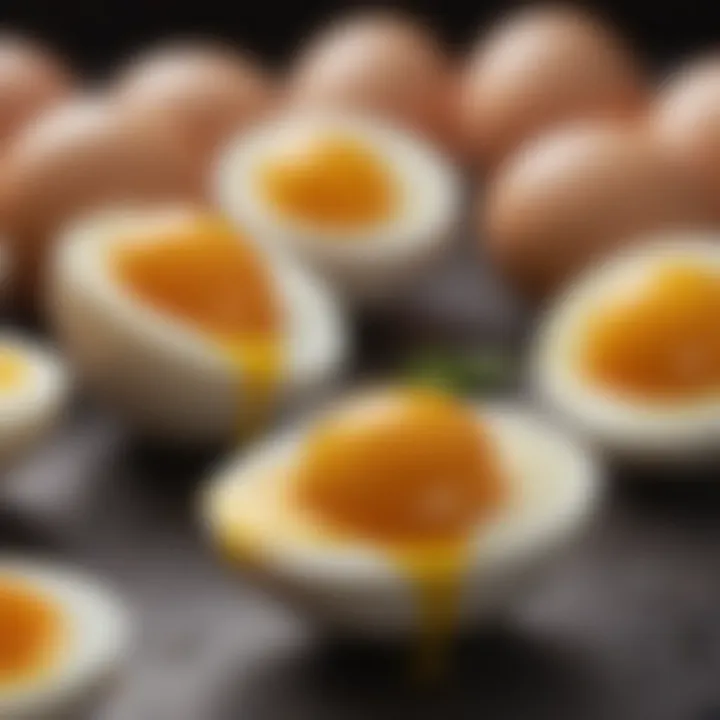
Intro
In this article, we will explore the various facets of achieving the ultimate soft boiled egg. We will delve into techniques, tools, and the science behind the cooking process. Whether you are a novice in the kitchen or an experienced chef, this guide offers valuable insights to consistently create a soft boiled egg that is both visually appealing and deliciously satisfying.
Wellness
Physical Health
Soft boiled eggs are not just a breakfast staple; they also provide significant nutritional benefits. They are rich in protein and contain essential vitamins and minerals. Regular consumption can contribute to muscle repair and growth, making them a great addition to a balanced diet.
Nutrition and Diet
Incorporating soft boiled eggs into your diet supports various nutritional goals. Their protein content can help maintain energy levels throughout the day. Additionally, they are low in calories but high in essential nutrients, making them an ideal choice for those mindful of their weight.
"A well-cooked soft boiled egg can serve as both a nutritious meal and a delightful gastronomic experience."
Tools for Cooking Soft Boiled Eggs
To achieve the ideal soft boiled egg, certain kitchen tools can enhance your cooking precision. Here are some recommended essentials:
- Timer: Ensures you cook eggs for the precise time needed for that perfect soft texture.
- Pot: A medium-sized pot provides enough space for multiple eggs without crowding.
- Ice Bath: A bowl of ice water helps stop the cooking process immediately after boiling, preserving the desired consistency.
Cooking Techniques
Understanding the various cooking methods can also influence your results. The most common methods for soft boiling are stovetop boiling and steaming. Each method has its own merits:
- Stovetop Boiling: This method involves submerging eggs in boiling water for a specified time.
- Steaming: Utilizing steam can create a gentler cooking environment, which helps in controlling the texture better.
Understanding the Soft Boiled Egg
The soft boiled egg is a culinary delight that combines a delicate white with a rich, creamy yolk. Understanding this dish is essential for anyone seeking to master breakfast or enhance their cooking skills. Its appeal lies in its versatility and the balance of textures that make it enjoyable in various dishes.
Definition and Characteristics
A soft boiled egg is typically cooked in its shell, submerged in boiling water for precisely eight to seven minutes. The primary characteristic is its runny yolk, which contrasts beautifully with the fully set egg white. This precise cooking method can yield variations based on the actual timing and starting temperature of the eggs. The common benchmark is a slightly molten yolk that enhances the overall flavor of the egg. It is also essential to note that the shell should be void of cracks to ensure a consistent cook.
Culinary Applications
Soft boiled eggs are not merely a breakfast item; they bridge multiple culinary worlds.
- Breakfast: Often served atop toast or in a classic breakfast bowl, soft boiled eggs enhance morning meals.
- Salads: They serve as a protein addition in salads, providing a contrast of temperatures and textures.
- Asian Dishes: In many Asian cuisines, they are served as a topping for ramen or rice bowls, elevating the entire dish.
- Soups: Soft boiled eggs can act as a garnish, enriching the flavor profile and offering a visual appeal.
"A soft boiled egg introduces a luxurious element to even the simplest of meals, making it a sought-after ingredient."
In a world where culinary simplicity often meets elevated execution, the soft boiled egg finds its place as a staple. Understanding this dish allows cooks to appreciate its subtleties, ensuring they achieve the perfect texture and flavor each time. The remarkable nature of soft boiled eggs gives them the ability to transform the ordinary into something extraordinary.
Selecting the Right Eggs
The quality of the egg fundamentally affects the outcome of your soft boiled egg. Choosing the right type of egg can enhance flavor, texture, and overall satisfaction. Understanding what to look for ensures that you achieve the ideal consistency and taste you desire.
Types of Eggs Available
When discussing eggs, variety is abundant. Commonly available eggs include chicken, duck, and quail. Each type brings its unique attributes to the table.
- Chicken Eggs: Most widely consumed. Available in various colors, including white and brown. The flavor is mild, making them versatile.
- Duck Eggs: Slightly larger and richer than chicken eggs. They have a creamier texture and can better withstand cooking without breaking.
- Quail Eggs: Smaller and delicately flavored. Ideal for gourmet presentations. Though they need more precise cooking for soft boiling due to their size, the result can be quite impressive.
Choosing organic or free-range options may also be beneficial. These methods often provide better conditions for hens and can yield eggs with richer flavors and nutritional profiles.
Freshness Indicators
Freshness plays a crucial role in egg quality. The more fresh the egg, the better the cooking experience and the final product. Several signs can help determine freshness:

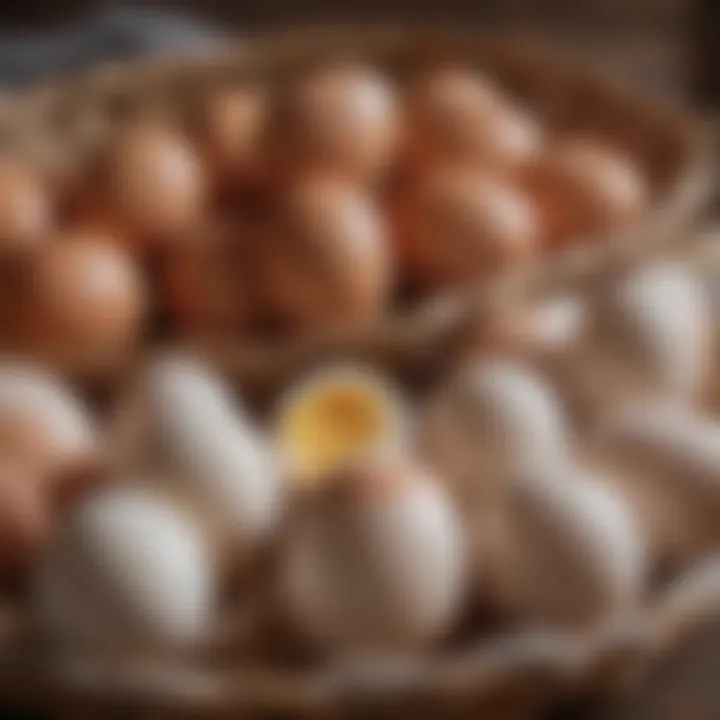
- Float Test: Place the egg in water. Fresh eggs sink to the bottom, while older eggs tend to float.
- Shell Texture: Fresh eggs have a smooth and matte shell. Older eggs may feel slimy or sticky due to bacteria.
- Yolk Appearance: When cracked, fresh egg yolks stand tall and firm, while older yolks flatten out.
Paying attention to these details can save you from cooking eggs that do not meet expectations. Properly selected eggs elevate the humble soft boiled egg into a comforting and delightful experience.
Essential Tools for Cooking
To achieve the perfect soft boiled egg, certain tools become essential in the cooking process. These items not only enhance accuracy but also simplify the overall experience of cooking. Choosing the right tools can significantly impact the final result, ensuring the right texture and flavor. The goal is to combine convenience with precision to elevate this dish from ordinary to extraordinary.
Egg Timer
An egg timer is a vital tool when cooking soft boiled eggs. This device can greatly assist in monitoring time without distraction. Depending on the egg's size and starting temperature, the ideal cooking time varies. A precision egg timer will take all these factors into account, simplifying the decision-making process. With an egg timer, you can focus on other elements of your meal without constantly checking a clock. Investing in a reliable egg timer ensures consistently perfect results.
Saucepan Selection
Choosing the right saucepan is equally crucial. A heavy-bottomed saucepan is preferable. This material provides even heat distribution. It helps prevent hot spots that could lead to uneven cooking. The size of the saucepan should also be considered. It needs to accommodate the number of eggs without overcrowding. Allow some space for water to circulate around each egg. A good rule of thumb is to use a saucepan that can boil at least two inches of water above the eggs. This ensures adequate coverage and allows for optimal cooking.
Ice Bath Requirements
An ice bath is a critical element in the soft boiling process. Once the eggs have reached the desired doneness, immediate cooling is essential. The shock of cold water halts further cooking, preserving the soft texture of the yolk. To prepare an effective ice bath, fill a large bowl with ice and cold water. The mixing of water and ice should create a post-cooking environment that rapidly reduces the egg's temperature. This process also makes peeling much easier, reducing the risk of damaging the delicate egg whites.
"A well-executed ice bath can mean the difference between a perfectly cooked soft boiled egg and an overcooked disappointment."
In summary, equipping your kitchen with effective tools can transform the process of making soft boiled eggs. An egg timer, proper saucepan, and ice bath setup are indispensable players in cooking success. With the right tools, you can focus on perfecting other aspects, all while ensuring a delightful soft boiled egg dish that impresses any guest.
The Cooking Process
The cooking process of a soft boiled egg is essential for achieving the desired texture and flavor. Here, the focus is not just on boiling water; it is about creating an environment where the egg can cook perfectly. Understanding the nuances of water temperature and timing is vital. Timing influences the final product, ensuring that the yolk remains luscious while the egg white is set. The process is systematic, but it requires attention to detail for the best results.
Water Temperature Considerations
Water temperature is pivotal in the cooking process. It affects how the heat transfers to the egg. Starting with cold water creates a gradual heating process. This method allows for even cooking, reducing the risk of rubbery whites or overly firm yolks. Ideally, water should be brought to a gentle boil rather than a vigorous one; this helps maintain a stable environment.
The common temperature range for soft boiling an egg is around 70 to 80 degrees Celsius (158 to 176 degrees Fahrenheit). Monitoring the temperature can prevent overheating. If the water temp is too high, it can cook the egg too fast, compromising the texture.
Timing Guidelines
Timing is crucial in soft boiling eggs. Each second counts in determining the yolk's consistency. The cooking time varies depending on how you prefer your yolk.
Soft Yolks
Soft yolks are a hallmark of a perfectly cooked egg. They offer a creamy, almost liquid consistency. To achieve soft yolks, cook the eggs for about 6 to 7 minutes. This time frame ensures the white is set while the yolk remains runny. Soft yolks are particularly desirable when used in various dishes. They can enhance flavors and provide visual appeal. However, this method has a narrow margin for error. Overcooking can lead to a firmer yolk, which might not be to everyone’s preference.
Firm Yolks
For those who prefer firmer yolks, cooking for 8 to 10 minutes is necessary. Firm yolks retain some creaminess yet are more solid than their softer counterparts. This style suits many baking and cooking applications where a firmer texture is ideal. While the advantage is versatility, there are nuances. If overheated, the yolk may develop a chalky texture. This alteration could detract from the overall quality.
Cooking Methods
The choice of cooking method plays a significant role in the final product. The two primary techniques are classic boiling and steaming, each offering unique attributes.
Classic Boiling
Classic boiling is a straightforward method that many are familiar with. Submerging the eggs in boiling water provides rapid cooking. This method is beloved for its simplicity. With the right water temperature and timing, classic boiling can yield excellent results without intricate tools. However, it does require regular monitoring. If the boiling is vigorous, the risk of cracking increases. Adjusting the heat after the initial boil is sometimes necessary.
Steaming Techniques
Steaming is increasingly popular among culinary enthusiasts. This method utilizes steam to cook the eggs, which can lead to less cracking. Steaming also allows for better control over the cooking environment. With steaming, eggs can be positioned in a basket or on a rack above the water, preventing direct immersion. This gradual cooking can provide a more consistent result. However, it may require a steamer or a pot with a rack, which some may not have readily available.
Regardless of the method chosen, paying attention to both timing and temperature is vital. Mastering these components elevates the humble soft-boiled egg into a truly refined dish.
Post-Cooking Techniques
Post-cooking techniques play a vital role in achieving the perfect soft boiled egg. While the cooking process is crucial, the steps taken immediately afterward can significantly affect the overall quality and presentation of the egg. This section explores two main techniques: cooling in an ice bath and effective peeling strategies. Both actions are designed to preserve the delicate texture of the yolk and the egg white, maintaining the ideal consistency that is sought after by those who appreciate this culinary art.


Cooling in Ice Bath
Cooling the soft boiled egg in an ice bath is an essential step. This technique halts the cooking process instantly and prevents overcooking, which can result in undesirable texture changes. An ice bath consists of a bowl filled with cold water and ice cubes. After removing the eggs from the boiling water, placing them immediately into this icy mixture helps to lock in the soft, runny yolk that is characteristic of a well-cooked soft boiled egg.
Benefits of an Ice Bath:
- Prevents Overcooking: The shock of cold water stops residual cooking, ensuring that the yolk remains perfectly runny.
- Easy Handling: The cooling process makes the eggs easier to handle, as they become less hot to the touch.
- Better Peeling: Chilling can assist in loosening the shell from the egg, which simplifies the peeling process, resulting in cleaner eggs.
To implement this technique effectively:
- Prepare a bowl filled with ice and water before cooking the eggs.
- Once the eggs are done cooking, transfer them carefully into the ice bath.
- Let them sit for about 5-10 minutes before peeling. This will yield the best results in terms of texture and ease of peeling.
Peeling Strategies
Peeling soft boiled eggs can often be a frustrating task. A delicate shell can tightly cling to the egg, making the process tedious. Employing effective peeling strategies can transform this task into a more manageable one.
Strategies for Peeling Soft Boiled Eggs:
- Use Fresh Eggs: Although fresh eggs may seem ideal for certain dishes, slightly older eggs are easier to peel because the pH level of the egg white increases, reducing its adhesion to the shell.
- Crack Before Peeling: Gently tapping the eggs at both ends and rolling them to create small cracks can soften the shell, making it easier to remove.
- Peel Under Running Water: Peeling the eggs under a stream of cool running water can help the shell slip off more easily, as the water can seep beneath the shell's membrane.
"Proper peeling methods can significantly enhance the eating experience, providing not just visual appeal but also ease of consumption."
Serving Suggestions
Serving suggestions are integral to enhancing the experience of consuming a soft boiled egg. While it stands well on its own, presentation and pairing can elevate this simple dish into a culinary delight. Thoughtfully chosen accompaniments not only complement its texture and flavor but also make the dish more visually appealing. In this section, we will explore various plating techniques and accompanying foods that enhance the overall experience.
Plating Techniques
The way a soft boiled egg is plated can significantly affect how it is perceived. A minimalistic approach is often best, allowing the egg's natural beauty to shine. You can serve it in an egg cup, which lends a sense of elegance. Alternatively, consider using a small bowl with a bed of greens or grains to provide contrast in color and texture.
Using garnishes like finely chopped herbs or a sprinkle of paprika can introduce an added layer of flavor without overwhelming the dish. Keep it simple; the focus should remain on the egg, its soft yolk inviting each diner to explore its creamy texture.
Accompaniments
Accompaniments further enhance the dining experience. Here we discuss three popular choices:
Toast Points
Toast points are a classic accompaniment to soft boiled eggs. These triangular pieces of toast provide a crunchy texture that contrasts nicely with the egg’s creaminess. The appeal of toast points lies in their ability to scoop up the soft yolk, allowing the eater to enjoy both components in each bite.
Although they are easy to prepare, the type of bread matters. A sourdough or whole-grain bread can add a nice flavor dimension. However, the simplicity of white bread shouldn't be dismissed either; it remains a popular choice for its straightforward flavor.
Salads
Salads offer a refreshing complement to soft boiled eggs. The crispness of fresh vegetables contrasts beautifully with the velvety yolk. A simple arugula or mixed green salad can provide a peppery note, which works particularly well. Adding a light vinaigrette can enhance the flavors without overwhelming the palate. One disadvantage might be conflicting flavors if the salad is too complex, so keeping it simple is key.
Soups
Soups can also pair well, especially when served alongside a soft boiled egg. A light broth can provide warmth and depth to the meal, creating a satisfying balance. Opt for broths that are flavorful but not too heavy, like a miso or a vegetable-based soup.
The combination of the warm soup and the soft egg can be comforting. However, care should be taken not to overshadow the delicate flavor of the egg itself.
Incorporating thoughtful serving suggestions can elevate the soft boiled egg from a simple dish to a nuanced culinary experience.
Common Pitfalls
Understanding common pitfalls is essential in achieving the perfect soft boiled egg. Many novice cooks encounter challenges that may deter them from mastering this culinary skill. Recognizing these errors allows one to avoid disappointment and produce a consistently delightful result. This section will address the two most notable pitfalls: overcooking the eggs and underestimating their freshness. Both components play a crucial role in the final product.
Overcooking Risks
Overcooking a soft boiled egg is perhaps the most prevalent mistake. This can happen easily, particularly for those who rely on rough cooking times without considering individual equipment or egg characteristics. When eggs are overcooked, they lose their desired creamy yolk consistency. Instead of the envisioned silky texture, you end up with a dry or crumbly yolk, which contrasts starkly with the intended outcome.
To avoid this, it is vital to follow precise timing guidelines. A common recommendation is to simmer the eggs for approximately six to eight minutes, but this can vary. The size of the egg, starting temperature (room temperature versus cold), and altitude can influence timing. Using an egg timer or a kitchen app can help monitor the process tightly. To further minimize risks, it is wise to prepare an ice bath in advance, allowing for immediate cooling after cooking. This stops the cooking process and helps maintain the perfect softness of the yolk.
Underestimating Freshness
The freshness of the eggs is another common consideration that can significantly impact the quality of the final dish. Many cooks may not pay enough attention to freshness, believing that any egg will suffice. However, fresh eggs are crucial for the best texture and flavor. Older eggs, while still usable, tend to have larger air cells; this can lead to difficulties when peeling and can alter the taste.
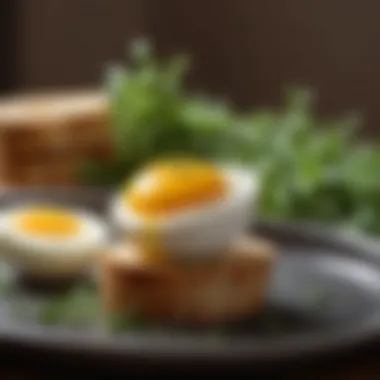
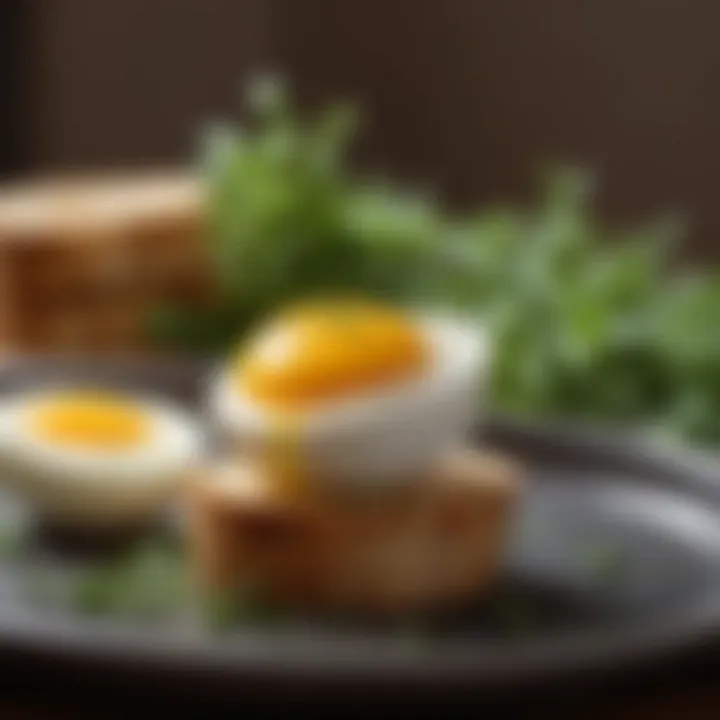
To determine the freshness of an egg, consider the water test. Place the egg in a bowl of water:
- Fresh Eggs: They will sink to the bottom.
- Slightly Older Eggs: They may stand upright but still touch the bottom.
- Bad Eggs: They float to the surface, indicating significant air cell expansion.
Additionally, examine the shell for any cracks or unusual odors when you break it open. Taking the time to select quality eggs is worth the effort since it greatly contributes to the dish's overall appeal.
"A small mistake in cooking time or egg quality can lead to a disappointing soft boiled egg experience. Always pay attention to timing and egg freshness to ensure success."
By being vigilant about both overcooking risks and egg freshness, one can truly appreciate the art of soft boiling eggs. These considerations should not be overlooked, as they significantly enhance the eating experience.
Nutritional Profile
Understanding the nutritional profile of a soft boiled egg is essential for anyone aiming to incorporate this dish into their diet. Eggs are often celebrated for their balance of macronutrients and vitamins. They provide a valuable source of protein, which is crucial for muscle repair and overall body function. Additionally, eggs contain essential fatty acids that support brain health and cell function.
One large soft boiled egg contains about 6 grams of protein, which contributes to a sense of fullness, making them a suitable addition to various diets. The nutrient density of eggs offers a comprehensive profile of vitamins and minerals, including B vitamins, vitamin D, selenium, and choline. Choline, in particular, is significant for brain health and cognitive function.
Moreover, the healthy fats found in eggs can help maintain heart health when consumed in moderation.
"Eggs are nutrient-rich foods that offer essential health benefits, making them a practical choice for a balanced diet."
Consuming eggs regularly can enhance daily nutrient intake, especially for individuals trying to improve energy levels and maintain a healthy weight. However, it is also important to consider the dietary cholesterol present in eggs. Although dietary cholesterol has a smaller impact on blood cholesterol levels than previously thought, individuals with specific health concerns or dietary restrictions should consult healthcare professionals before increasing egg consumption.
Cultural Variations
Understanding the cultural variations in cooking soft boiled eggs enriches the experience of this seemingly simple dish. Different cultures showcase their unique methods, preferences, and traditions surrounding soft boiled eggs. This diversity not only highlights global culinary creativity but also serves as a reminder of how food can bridge gaps between people. By exploring these variations, cooks can experiment and innovate, leading to exciting flavors and presentations that enhance the dish’s appeal.
Global Perspectives
Around the world, soft boiled eggs are treated with a distinct sense of reverence. In Japan, for example, the onsen tamago is a specialty, characterized by a gentle cooking method in hot spring water. This technique results in eggs with a creamy texture and a slightly sweet taste, often served with soy sauce or dashi. In contrast, in France, eggs are often served à la coque, where the egg remains in its shell after cooking, offering a sophisticated take on presentation and enjoyment. This cultural nuance illustrates how the same basic concept of a soft boiled egg can transform into unique culinary treasures across different regions.
Cultural interpretations also carry significance in how eggs are incorporated into meals. In many Asian cuisines, such as in Korea, soft boiled eggs are integral to breakfast, commonly served alongside rice and various side dishes, enhancing the meal's overall harmony. In Western contexts, soft boiled eggs might be featured in a brunch setting, paired with toast or salads. Each culture’s approach to the soft boiled egg, therefore, reflects not just culinary preferences, but also social customs and mealtime behaviors.
Regional Cooking Techniques
Regional cooking techniques contribute further to the diversity of soft boiled egg preparation. For instance, in countries where steaming is more commonplace, this method is often preferred to preserve the delicate yolk without the concerns of overcooking. On the other hand, places like Italy may favor a traditional boiling approach, ensuring the soft boiled egg is consistently creamy and fully flavorful.
When it comes to seasoning, different regions impose their own culinary identities as well. In the Middle East, for instance, spicing up soft boiled eggs with za'atar or sumac adds depth and vibrance. In other places, a sprinkle of salt and pepper may suffice. The methodology combined with regional flavor profiles paints a rich tapestry of how a simple soft boiled egg can take on numerous forms, much like the cultures they originate from.
"Food is a universal language, and soft boiled eggs are a delicious dialect among cultures worldwide."
Through these cultural variations, we appreciate that the soft boiled egg is more than just a component of breakfast; it is a reflection of societal values, culinary traditions, and the innovation of flavors. By recognizing these layers of meaning, cooks can elevate their culinary experience and foster a deeper connection to the dishes they create.
Exploring Advanced Techniques
In the quest for the perfect soft boiled egg, exploring advanced techniques can significantly improve results. While basic boiling methods may yield satisfactory outcomes, advanced techniques like sous vide and precision timing provide a greater degree of control over the eggs' texture and consistency. Understanding these methods not only enriches your culinary skills but also enhances your overall cooking experience.
Sous Vide Cooking Methodology
Sous vide is a French term meaning "under vacuum". This method involves sealing food in a plastic bag and cooking it to a very precise temperature in a water bath. Using sous vide for soft boiled eggs offers several benefits. Firstly, it allows for consistent doneness throughout the egg. The water temperature remains stable, and the egg can be cooked for extended periods without the risk of overcooking.
To cook soft boiled eggs sous vide, set the water temperature to 75°C (167°F). Place the eggs in the water bath for 45 minutes. This process yields a perfect creamy yolk with a tender white, ideal for salads or ramen soup.
Advantages include:
- Precision: Exact temperature control leads to desirable textures.
- Convenience: Set it and forget it until the eggs are done.
- Versatility: Eggs can be held at the desired temperature until you're ready to serve.
Precision Timing Tools
Timing is crucial when cooking soft boiled eggs. Using reliable precision timing tools can assist in achieving the desired consistency. Various kitchen gadgets are available to help track cooking time accurately.
One recommended tool is an egg timer. These timers typically change color to indicate when the eggs reach soft, medium, or hard boiledd stages. Alternatively, digital timers or smartphone apps can offer precise countdowns.
Consider these points when selecting timing tools:
- User-friendly Interface: A simple and clear display can save time and reduce mistake.
- Multiple Timing Options: Some timers allow you to set different times for multiple eggs.
- Portability: Some timers are compact enough to use anywhere in the kitchen.
"Achieving perfection in soft boiled eggs requires precise timing and accurate temperature control, making the right tools essential."
Using these advanced techniques can elevate the soft boiled egg from a simple dish to a sophisticated culinary masterpiece. Embracing methods like sous vide and incorporating precision tools can lead to consistent and impressive outcomes.



